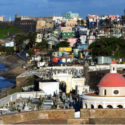Economists Rafael Romeu and José Pineda of DevTech Systems are defending their projections for Puerto Rico in the new fiscal plan. In an article in El Nuevo Dia, the two, who worked with previous administrations in Puerto Rico, were firm in their rejection of the claims that the current government’s new fiscal plan is “not well-founded.” However, they have a strong “if” in their predictions.
“The success of the Puerto Rican economy in the future lies in increasing the size of the labor force,” Pineda was quoted as saying.
Puerto Rico has been losing jobs and population at startling rates for years. Not only have many people left Puerto Rico, but the birth rate is low and the population as a whole is aging. Economist Brad Setser says the new fiscal plan’s predictions work only if Puerto Rico can “build back better” in a way that makes the Island more like a state. For Setser, too, population is the key to success:
“There is a case for optimism,” he says. “Puerto Rico could, conceivably, put itself on a trajectory where living standards converge toward those in the fifty states—it could ‘build back better.’ Stronger underlying productivity growth and rising labor force participation could offset the negative demographics and the strain an aging population naturally places on public services.”
“Like a state” isn’t good enough.
We’ve seen efforts to make Puerto Rico “like a state” before. Giving Puerto Rico the power to vote in presidential elections without actually becoming a state — that’s an idea that has been tried and failed. Giving Puerto Rico the tax benefits of a state, like EITC, have been recommended and proposed and rejected repeatedly. Asking for fair treatment under Medicaid and other federal programs — it seems as though the government would say, “Oh, we didn’t know the situation was so unfair — we’ll fix that right away.” That’s not what happens, though.
Puerto Rico is like a state in many ways. Where Puerto Rico is very different from a state is this: states have senators and voting congressional representatives. Without those strong voices, Puerto Rico is a powerless territory.
Does population increase after statehood?
Hawaii’s population increased by more than 26% between 1950 and 1960. Alaska’s increased by more than 73%. Arizona, admitted in 1912, saw a 61% population increase in the decade in which it became a state. We could keep going. Statehood leads to an increase in population.
Part of this is economics. Hawaii had a boom not only in its tourist industry but also in manufacturing and construction when it became a state. Puerto Rico can expect many new jobs as part of rebuilding. The stability of statehood should lead to greater stability for business.
What’s the alternative? Continuing as an unincorporated territory. How has that been working out for Puerto Rico? It is time to move forward, not backward. Puerto Rico should be a state. Tell your representatives.








One response
Hola! After 120 years of fellow US Citizens in the US Territory (Colony-since 1898) of our our noble USA, it is high time that the Federal Government cut Puerto Rico’s undemocratic Territorial Shackles; end un-equal US Citizenship (includes American Veterans-Patriots of True Grit)– who can’t VOTE for their US President/Head of State; don’t have just representation in the US Congress that determines their destiny; don’t have full earned benefits nor parity in Federal Laws; nor a permanent statutory US Citizenship…
THE TIME IS NOW for the FEDERAL GOVERNMENT (US President, US Congress, and US Supreme Court) to ACT. provide: EQUALITY+JUSTICE+PROGRESS=STATEHOOD with DIGNITY!
With TRUTH, REASON, COURAGE, and CIVIC ACTION–WE WILL OVERCOME!